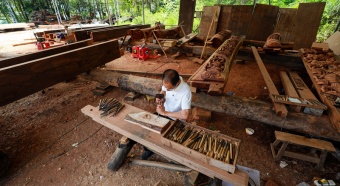Photography now is easily realizable, yet 40 years ago, the case was quite the opposite. Back then, camera was a rarity unaffordable for common people, who had to go to the photo studio for a family photo, preparing in advance, putting on clean clothes…just like celebrating a big festival.
There was only one state-run photo studio in our county, thus the business was hot. We usually paid for tickets first, and waited for quite a while. The camera with a tripod was covered with a large piece of cloth, into which the cameraman put his head. Then he had his head out and a ball-like thing on his hand pressed, totally costing more than an hour. After the photo was taken, it can’t be washed out until a week later. As photography then was troublesome and costly, there were very few photos left, it is thus especially precious to see the photos of those days.
I worked in the Linchi Farm in Ningdu County, Jiangxi Province in December 1974. Two years later, I was luckily assigned to do paperwork in the office because of my favorable performance. During hand-over with the senior paperwork man, I opened an iron box, an old camera wrapped in red cloth appeared. Made in a foreign country (as for which country, no one known), the 20-year-old camera had to be held with both hands during photography. I carefully studied this camera, but it was always out of order, whether be the switch or partial exposure. What’s more, the photos had to be washed by ourselves, entailing a dark room, special potion for washing photos... Gradually lost interest in the camera, I had to ask professional county photographers living in cities 60 kilometers away for help.
Camera is one of the best ways to record historical data, originally and authentically. Due to scarcity of photographic equipment, some necessary images of the farm were not left. For example, images concerning division of mountains and fields, and the boundary between the field and the town were absent, leaving hidden dangers for future; moving stories like transforming cold paddy fields and other advanced models could not be expressed vividly except for narrative log.
After the reform and opening up, more and more cameras came into people’s daily life, with point-and-shoot cameras gradually appearing and instant cameras followed. At that time, instant cameras and photo paper were so expensive that only few people could afford. As for point-and-shoot cameras, simple operation made it friendly to all people, but users had to buy films and have them developed. I remember there was a photography lover in our farm who bought a point-and-shoot camera at that time. He at first was warm-hearted to everyone who asked him to take photos. As the number of people asking him for help increased, he used lots of films and spent much time developing films. Finally, he no longer took photos for others, saying his camera was out of order.
In the 1990s, the brick-sized “Big Brother” (a cell phone) was the mainstay, and then the palm-sized cell phone. From analog phones to smart phones, from 2G to 4G, the camera in cell phones became more and more powerful, allowing both functions of photography and cinematography. Image clarity and convenience have also been massively improved, it can even be said that everyone is a videographer. Taking photos was like celebrating a big festival in the past, yet now photography is no big deal.
On November 15, 2017, Linchi Farm celebrated its 60th anniversary, and I was invited to participate. The appearance of the farm has been renewed, and corresponding photos recorded in the newly compiled log. Reading the new log, I found that the continuation part was illustrated with clear pictures, facilitating readers’ understanding. Looking at the pictures concerning comparisons of the new and old worker dormitories, and streets before and after redesign, especially the new boundary lines between farms and mountains, I was reminded of the working period and deeply felt the changes of the times. During the warm celebrations, fellow workers who had worked together for many years recorded several touching shots with their phones, forming a friendly atmosphere. At the same time, those who came from remote places and revisited where they had worked before took photos of this memorable place and shared this happiness on Weibo and Moments with fellow workers who failed to attend.
Easier access to cameras demonstrates our progress in science and technology and enhancement of national strength. The rapid development of mobile phones indicates great improvement of China’s independence. Statistics reveal that in 2017, Chinese brand mobile phone production accounted for almost half of the global market share, reaching 48.50%. In the 2017 domestic mobile phone sales, the top four brands were all homemade, with Huawei in the lead, followed by OPPO, vivo and Xiaomi. This also reflects that people are enjoying an improving living standard and a better life. Let’s record both the history and the better time with our phones. Let’s take photos of our smiling faces with our phones to show the senses of happiness and gain that only the people of the new era could have.









